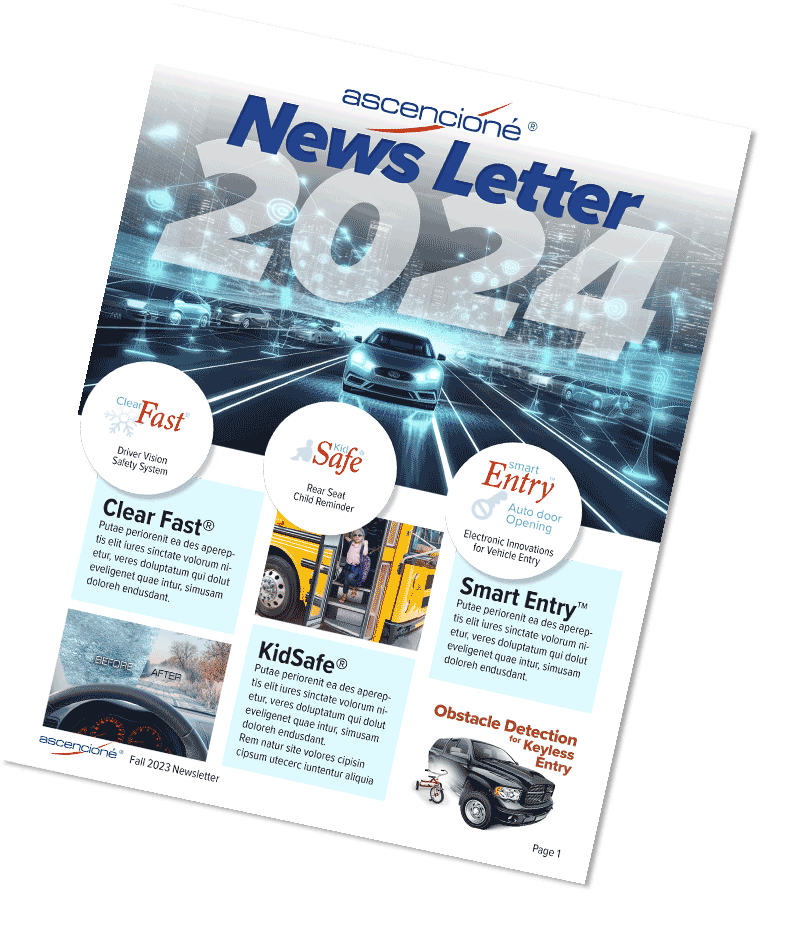“Control” of Sense, Compute, and Control®
Unleashing the Power of Control Systems in Automotive Technology

Control, the final pillar of Ascencione’s Sense, Compute, and Control framework, represents the culmination of intelligent decision-making and precise execution within automotive engineering. Our controllers serve as the muscle of vehicle dynamics, seamlessly integrating sensory inputs with computational algorithms to optimize performance, enhance safety, and elevate the driving experience. With advancements in sensing technologies providing a wealth of real-time data, our controllers empower vehicles to adapt dynamically to changing conditions, ensuring optimal operation across a diverse range of scenarios. From managing power distribution in electric propulsion systems to fine-tuning suspension characteristics for optimal ride comfort, our control solutions embody innovation and efficiency, driving the evolution of automotive technology towards a smarter, safer, and more connected future. Join us as we delve into the intricacies of control systems and explore how they shape the vehicles of tomorrow.
Table of Contents
Sense:
- Sense because our sensors measure: Linear and rotary position, Distance / location, Velocity, Fluid level / flow, Pressure, Temperature, Light, Acceleration, Force, Touch, and Proximity.
Compute:
- Compute because our processors think: Embedded systems, Logic & intelligence, Electronic hardware, Filtering, Signal processing, Signal analysis, PID control, Software algorithms, Operating systems, Data communications, User interface /UX.
and Control®:
Control because our controllers empower: Mechatronic systems, Motor control, Actuators, Kinematics, Open / closed loop, Electric / fluid power, Lighting, Displays, Haptics, and Rheologial fluid torque
In this article we will focus on the control portion of Sense, Compute, & Control®. Overview of Various Sensor Types and Their Importance.
Our controllers empower:
Mechatronic Systems – Integrating
Mechanical and Electronic Control
Definition and Components of Mechatronic Systems
Mechatronic systems combine mechanical, electrical, and computer engineering components to create intelligent, multi-functional systems capable of precise control and automation.
Sensors for Feedback and Input
Sensors serve as the eyes and ears of mechatronic systems, providing crucial feedback and input by detecting and measuring various physical phenomena such as temperature, pressure, position, and velocity. These sensors translate real-world signals into electrical signals that can be processed by the system’s control algorithms, enabling it to make informed decisions and adjustments in response to changing conditions.
Actuators for Output and Control
Actuators serve as the muscle of mechatronic systems, translating control signals generated by the system into physical actions or outputs. These outputs can include movements, forces, or other desired responses, allowing the system to interact with its environment and perform tasks ranging from adjusting vehicle steering to regulating fluid flow in industrial processes.
Applications in Automotive Engineering
Automotive electronic systems represent a revolutionary frontier, transforming vehicle design, performance, and functionality. These systems encompass technologies like advanced driver assistance systems (ADAS) and sophisticated infotainment solutions. ADAS technologies enhance safety through features such as lane departure warning and automatic emergency braking, while infotainment systems offer connectivity and entertainment options. As electronic systems evolve, they promise to make vehicles safer, more efficient, and more enjoyable to drive.
List of Mechatronic Systems we’ve developed through the years: motorized Air Vents

Motor Control: Mechanisms in Automotive Technology
Techniques for Controlling Electric Motors
Techniques for controlling electric motors play a crucial role in modern automotive engineering, offering precise and efficient control over propulsion systems. Pulse Width Modulation (PWM) is a widely used technique that regulates the power supplied to electric motors by varying the width of the pulse signal. By adjusting the duty cycle of the pulses, PWM control can effectively modulate the speed and torque output of the motor, making it suitable for applications requiring variable-speed operation such as electric vehicle propulsion and motorized actuators.
Field-Oriented Control (FOC)
Field-Oriented Control (FOC) represents a sophisticated method for controlling electric motors with high precision and efficiency. FOC works by aligning the magnetic field generated by the motor’s rotor with a reference vector, allowing for independent control of torque and flux. This technique maximizes motor performance while minimizing losses, resulting in smoother operation, reduced energy consumption, and improved overall efficiency. FOC is commonly used in electric vehicle traction systems, industrial automation, and robotics, where precise control over motor behavior is essential for optimal performance.
Pulse Width Modulation (PWM)
In summary, Pulse Width Modulation (PWM) and Field-Oriented Control (FOC) are two advanced techniques for controlling electric motors in automotive applications. While PWM offers flexible speed and torque control by adjusting pulse width, FOC provides superior precision and efficiency by aligning the motor’s magnetic field with a reference vector. Both techniques play a critical role in optimizing the performance, efficiency, and reliability of electric propulsion systems in modern vehicles, contributing to the advancement of electric and hybrid vehicle technology.
Implementations in Vehicle Propulsion and Functionality
Implementations in vehicle propulsion and functionality encompass a diverse range of technologies aimed at optimizing power delivery and enhancing driving dynamics. One such technology is Electric Vehicle (EV) motor control, which plays a critical role in regulating the performance of electric propulsion systems. By precisely controlling factors such as motor speed, torque output, and energy efficiency, EV motor control ensures smooth and responsive acceleration while maximizing range and battery life. This technology is fundamental to the advancement of electric and hybrid vehicles, offering cleaner and more sustainable alternatives to traditional combustion engines.
Variable Valve Timing (VVT)
Variable Valve Timing (VVT) systems represent another key innovation in vehicle propulsion, enabling dynamic control over engine performance and efficiency. These systems adjust the timing of intake and exhaust valves to optimize airflow and combustion within the engine cylinders, improving power delivery, fuel economy, and emissions performance across a wide range of operating conditions. By varying valve timing according to engine speed, load, and driver demand, VVT systems enhance both the performance and efficiency of internal combustion engines, making them a cornerstone technology in modern automotive powertrains.
Implementations in vehicle propulsion and functionality encompass a diverse array of technologies designed to optimize power delivery, efficiency, and performance. From Electric Vehicle (EV) motor control, which drives the transition towards electrified propulsion systems, to Variable Valve Timing (VVT) systems, which enhance the capabilities of internal combustion engines, these innovations play pivotal roles in shaping the future of automotive propulsion. As automotive technology continues to evolve, these advancements will drive further improvements in vehicle efficiency, performance, and sustainability.
List of some Motor Control we’ve developed through the years: Chrysler Pulse width modulation – Fuel Pump Control Module
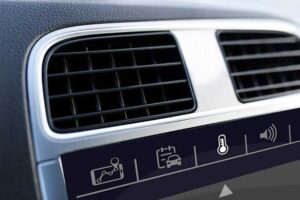
Actuators: The Muscle Behind Automotive Control
Types of Actuators Used in Vehicles
Types of actuators used in vehicles encompass a variety of mechanisms responsible for translating control signals into physical motion. Solenoids are one such type, utilizing electromagnetic principles to convert electrical energy into linear motion. These versatile actuators find applications in various automotive systems, including engine management, transmission control, and door locking mechanisms. Solenoids offer fast response times and precise control, making them ideal for applications requiring rapid and accurate actuation.
Hydraulic Actuators
Hydraulic actuators represent another common type of actuator employed in vehicles, harnessing the power of hydraulic fluid to generate mechanical force. These actuators rely on the controlled flow and pressure of hydraulic fluid to produce linear or rotary motion, making them suitable for applications requiring high force output, such as brake systems, power steering, and hydraulic suspension systems. Hydraulic actuators offer robust performance and can operate reliably under extreme conditions, making them indispensable components in modern automotive systems.
Solenoids
In summary, types of actuators used in vehicles include solenoids and hydraulic actuators, each offering unique advantages and applications in automotive engineering. While solenoids excel in providing fast and precise linear motion through electromagnetic principles, hydraulic actuators leverage hydraulic fluid to generate high-force mechanical motion, making them ideal for heavy-duty applications requiring robust performance. These actuators play critical roles in various automotive systems, contributing to the safety, performance, and functionality of modern vehicles.
List of some systems with actuators we’ve developed through the years: Ford B-Pillar KETS, Kidsafe Bus Doors Anti-Trap

Kinematics: in Automotive Engineering
Understanding Vehicle Motion and Dynamics
Understanding vehicle motion and dynamics is essential in automotive engineering for designing vehicles that offer optimal performance, handling, and safety. This field involves analyzing the complex interactions between a vehicle’s components, such as its suspension, tires, and powertrain, to predict how it will respond to various driving conditions. By understanding factors like weight distribution, center of gravity, and tire grip, engineers can optimize vehicle dynamics to deliver precise steering, stable cornering, and comfortable ride characteristics.
Forward and Inverse Kinematics
Forward and inverse kinematics are fundamental concepts in vehicle motion analysis, providing insights into how different parts of a vehicle move relative to each other. Forward kinematics involve predicting the position and orientation of a vehicle’s components based on their individual movements, while inverse kinematics work in reverse, determining the necessary movements of each component to achieve a desired overall motion. These concepts are invaluable in designing robotic systems for tasks such as vehicle assembly, as well as in developing advanced control algorithms for autonomous vehicles.
Differential Kinematics
Differential kinematics focuses on understanding the motion of a vehicle’s wheels and axles relative to each other. This field plays a crucial role in designing drivetrain systems, such as those found in cars, trucks, and other wheeled vehicles. By analyzing the relationships between wheel speeds, axle rotations, and vehicle trajectory, engineers can optimize differential mechanisms to ensure smooth power delivery, efficient traction control, and stable handling characteristics. Differential kinematics is essential for designing drivetrains that can adapt to various driving conditions, from navigating tight corners to traversing uneven terrain.
List of some systems with Kinematics we’ve developed through the years: Future Faraday Obstacle Detection
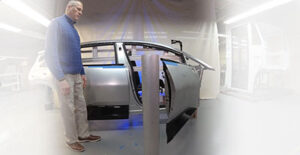
Open/Closed Loop: Control Systems
Differentiating Between Open and Closed Loop Control
Differentiating between open and closed-loop control systems is essential for understanding their respective advantages and limitations in automotive engineering and other fields. While open-loop control systems offer simplicity and efficiency in certain applications, closed-loop control systems provide greater accuracy, reliability, and adaptability through the use of feedback mechanisms.
Open Loop Control: One-way Communication
Open-loop control systems involve one-way communication, where the control action is predetermined based on a set of inputs without considering the system’s actual performance. These systems lack feedback mechanisms to adjust the control action based on real-time observations, making them less adaptable to changes in operating conditions and potentially less accurate in achieving desired outcomes.
Closed Loop Control: Feedback Mechanisms
In contrast, closed-loop control systems utilize feedback mechanisms to continuously monitor the system’s performance and adjust the control action accordingly. By comparing the actual output of the system to the desired setpoint, closed-loop control systems can make real-time corrections to maintain stability, accuracy, and reliability. This feedback loop enables closed-loop control systems to adapt to changes in the environment or system dynamics, resulting in more precise and robust control over various processes, including those found in automotive applications.
List of some systems with Open and Closed Loop Control we’ve developed through the years: SPS J1939 ECU, Obstacle Detection for Car doors, kidSafe® anti-trap bus doors.
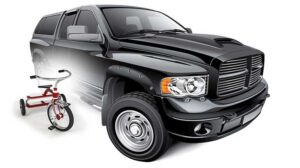
Electric and Fluid Power: Control
Utilizing Electric Power in Automotive Systems
Utilizing electric power in automotive systems has become increasingly prevalent as the automotive industry shifts towards electrification. Electric power offers numerous advantages over traditional mechanical systems, including greater efficiency, versatility, and responsiveness. From electric propulsion systems in electric and hybrid vehicles to auxiliary systems such as electric power steering (EPS) and electric brake assist systems, the integration of electric power enhances vehicle performance, fuel efficiency, and overall driving experience.
Electric Power Steering (EPS)
Electric Power Steering (EPS) represents a significant advancement in automotive technology, replacing traditional hydraulic power steering systems with electrically assisted ones. EPS systems utilize electric motors to provide steering assistance, adjusting the level of assistance based on vehicle speed and driver input. This technology offers several advantages, including improved fuel efficiency, reduced complexity, and enhanced reliability compared to hydraulic systems. Additionally, EPS enables the integration of advanced driver assistance features such as lane-keeping assist and automated parking, contributing to safer and more convenient driving experiences.
Electric Brake Assist Systems
Electric Brake Assist Systems are another example of how electric power is utilized to enhance automotive safety and performance. These systems utilize electric actuators to provide additional braking force when detecting emergency braking situations, helping to reduce stopping distances and prevent collisions. Electric brake assist systems work in conjunction with traditional hydraulic braking systems, offering rapid and precise response times to driver inputs and road conditions. By harnessing the power of electricity, these systems improve vehicle safety and stability, particularly in emergency braking scenarios, thereby enhancing overall driving confidence and peace of mind.
List of some systems with Hydraulic and Pneumatic Control we’ve developed through the years: SPS J1939 ECU, Chrysler Pulse width modulation – Fuel Pump Control Module

Lighting: Control Systems in Vehicles
Types of Vehicle Lighting Systems
Vehicle Lighting Systems come in various types, each serving specific purposes for safety and convenience on the road. Halogen lights, commonly found in older vehicles, emit a warm, yellowish light and are cost-effective. LED lights, on the other hand, are increasingly popular due to their energy efficiency and longevity. Xenon HID lights offer superior brightness and visibility, often used in high-end vehicles. Adaptive lighting systems dynamically adjust the direction and intensity of the headlights based on driving conditions, enhancing safety during nighttime and adverse weather.
Exterior Lighting: Headlights, Taillights
Exterior Lighting plays a crucial role in ensuring visibility and signaling intentions to other road users. Headlights illuminate the road ahead, aiding the driver’s vision and alerting pedestrians and other drivers of the vehicle’s presence. Modern headlights often feature advanced technologies such as automatic leveling and cornering lights to improve visibility around corners. Taillights serve as indicators of braking and turning, enhancing safety by communicating the driver’s actions to vehicles following behind.
Interior Lighting: Dashboard Lights, Ambient Lighting
Interior Lighting enhances the functionality and aesthetics of a vehicle’s cabin. Dashboard lights provide essential information to the driver, including speed, fuel level, and engine status, ensuring they can monitor the vehicle’s performance at a glance. Ambient lighting, available in various colors and intensities, creates a comfortable atmosphere within the cabin, enhancing the driving experience. It can also serve a functional purpose by illuminating footwells and door handles, aiding entry and exit in low-light conditions.
List of some systems with Control Mechanisms for Adaptive and Intelligent Lighting we’ve developed through the years: Flasher AM General, Flasher Truck-Lite, Military Vehicle Light Switch, Chrysler Integrated Center Stack.
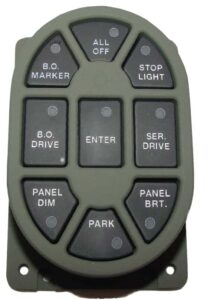
Displays: Visual Interface for Vehicle Information
Display Technologies Used in Automotive Applications
Display technologies play a crucial role in enhancing safety, comfort, and convenience in automotive environments, and both LCD and OLED technologies offer unique advantages to meet diverse requirements. LCDs excel in providing cost-effective solutions with reliable performance and versatility, making them suitable for a wide range of automotive display applications. On the other hand, OLEDs represent the pinnacle of display technology, delivering unmatched visual quality, energy efficiency, and design possibilities, elevating the in-car experience to new heights. As automotive manufacturers continue to innovate, incorporating advanced display technologies into their vehicles, drivers and passengers can expect increasingly immersive and intuitive interfaces that redefine the way they interact with their vehicles.
LCD (Liquid Crystal Display)
LCD (Liquid Crystal Display) technology has long been a staple in automotive applications, offering crisp and clear visual displays for various purposes. LCD screens are commonly found in instrument clusters, infotainment systems, and navigation displays within modern vehicles. These displays utilize liquid crystals controlled by electrical currents to modulate light and produce images. With advancements in technology, LCDs in automobiles have become more versatile, offering high resolution, wide viewing angles, and enhanced color reproduction, providing drivers with vital information and entertainment features seamlessly integrated into the vehicle’s interior.
OLED (Organic Light-Emitting Diode)
OLED (Organic Light-Emitting Diode) displays represent a cutting-edge innovation in automotive display technology, gaining popularity for their superior image quality and design flexibility. Unlike LCDs, OLEDs emit light individually for each pixel, resulting in deeper blacks, vibrant colors, and higher contrast ratios. This technology enables thinner and more energy-efficient displays, ideal for applications like dashboard screens, entertainment systems, and rear-seat displays. OLED displays also offer faster response times, contributing to smoother animations and improved user interaction, enhancing the overall driving experience while maintaining a sleek and modern aesthetic in the vehicle’s interior.
List of some systems with Displays we’ve developed through the years: SPS J1939 ECU, Ford B-Pillar KETS, Chrysler Integrated Center Stack.
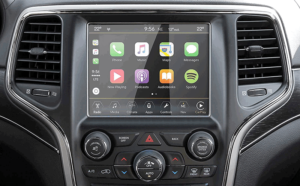
Haptics: Enhancing User Interaction in Vehicles
Haptic Feedback Mechanisms
Haptic feedback mechanisms are essential components in modern technology, enhancing user experiences by providing tactile sensations or vibrations in response to interactions with devices. These mechanisms utilize various techniques such as vibrating motors and electroactive polymers to simulate the sense of touch, enabling users to feel feedback in addition to visual and auditory cues. Haptic feedback is utilized in a wide range of applications, from smartphones and gaming controllers to automotive interfaces and virtual reality systems, enriching user interactions and improving overall usability.
Vibrating Motors
Vibrating motors play a crucial role in haptic feedback mechanisms, generating vibrations of different frequencies and intensities to simulate tactile sensations. These compact motors are commonly found in smartphones, wearables, and gaming devices, providing users with tactile feedback for actions like typing, tapping, and scrolling. By vibrating in response to user interactions, these motors create a more immersive and intuitive user experience, enhancing engagement and responsiveness in electronic devices.
Electroactive Polymers
Electroactive polymers (EAPs) represent an innovative approach to haptic feedback, utilizing the deformation of polymer materials in response to electrical stimuli to generate tactile sensations. Unlike traditional vibrating motors, EAPs offer the potential for more nuanced and lifelike haptic feedback, mimicking the sense of touch more accurately. This technology holds promise for applications in virtual reality, robotics, prosthetics, and wearable devices, where realistic tactile feedback is crucial for creating immersive and interactive experiences.
List of some systems with haptics we’ve developed through the years: Smart Touch Button for Glove Box
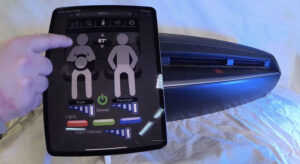
Rheological Fluid Torque: Control
Understanding the rheological properties of fluids is crucial in various fields, including chemical engineering, materials science, and food processing. Viscosity, a fundamental property, refers to a fluid’s resistance to flow. It is affected by factors such as temperature, pressure, and molecular structure.
Viscosity and Shear Rate
Shear rate describes the rate at which adjacent layers of fluid move relative to each other when subjected to a force. Viscosity and shear rate are inversely related: higher viscosity leads to lower shear rates, and vice versa. This relationship is pivotal in understanding fluid behavior in processes like mixing, pumping, and coating.
Yield Stress and Thixotropy
Yield stress is another important rheological property, representing the minimum force required to initiate flow in a viscoplastic material. Unlike Newtonian fluids, which flow continuously under any shear stress, viscoplastic fluids exhibit a yield point where they transition from solid-like behavior to fluid-like behavior. Understanding yield stress is essential in applications involving pastes, gels, and suspensions, where flow behavior is non-linear and influenced by external forces. Thixotropy is a phenomenon observed in certain materials where viscosity decreases over time under constant shear stress, followed by gradual recovery when the stress is removed. This property is significant in areas like paint formulation, where materials need to be easily applicable during stirring or spraying but maintain stability once applied. Understanding thixotropy aids in optimizing processes and ensuring product quality and consistency.
List of some Rheological Fluid Torque we’ve developed through the years: SPS J1939 ECU



